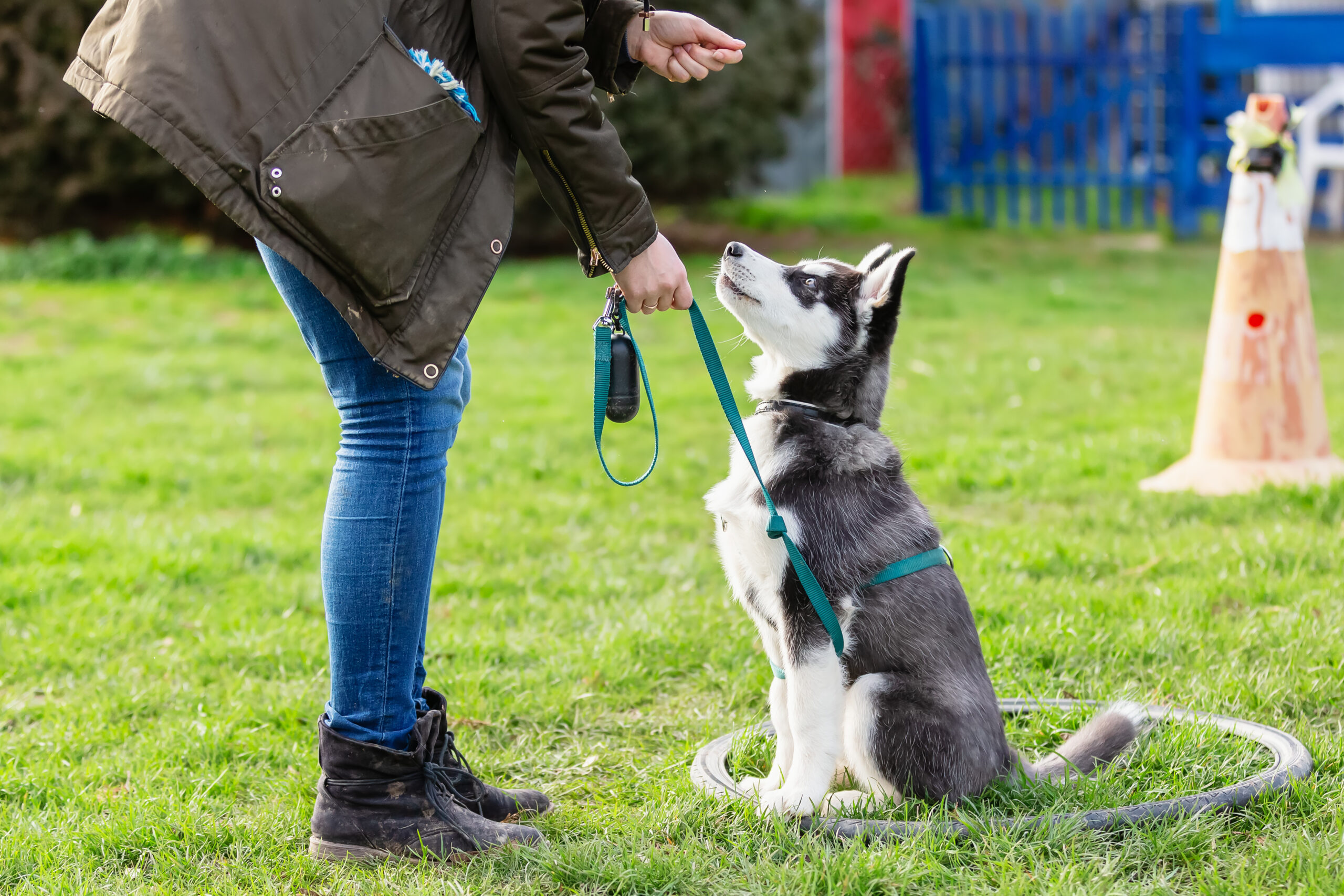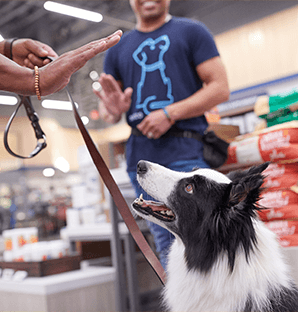Dog Training Near Me vs. Online Courses: Which Works Better?
Wiki Article
Effective Techniques for Successful Pet Dog Training: A Comprehensive Overview
Efficient canine training needs a nuanced understanding of canine actions. It hinges on the principles of positive reinforcement and consistency. Instructors must identify the relevance of important commands and socializing. Attending to common behavior issues can change a canine's personality. As the bond between proprietor and pet reinforces, the method they interact evolves. The trip of successful training incorporates numerous strategies that might shock also experienced family pet proprietors. What are the crucial elements that can make a substantial difference?Understanding Pooch Habits
Understanding canine habits is crucial for effective pet dog training, as it allows instructors to analyze a canine's activities and responses in different situations. Pet dogs communicate primarily with body language, articulations, and faces. Acknowledging indications of aggressiveness, tension, or anxiety can assist trainers adjust their methods to guarantee a positive training experience. For instance, a wagging tail does not always indicate happiness; the context and various other body hints need to be considered.In addition, recognizing a pet's breed-specific qualities can offer understandings right into their behavior patterns and impulses. Socialization plays a critical function fit a pet's responses to new individuals and settings. Observing a canine's play design can additionally reveal their temperament and convenience degrees. By meticulously assessing these habits, fitness instructors can create tailored strategies that cultivate discovering and reinforce the bond in between pet dog and owner, ultimately bring about even more effective training results.
The Value of Positive Reinforcement
Favorable support is a vital approach in dog training that boosts the discovering procedure by fulfilling preferred actions. This technique urges pet dogs to duplicate activities that yield positive outcomes, such as treats, praise, or play (Dog Training Near Me). By linking etiquette with benefits, canines come to be much more inspired and engaged throughout training sessions
Integrating favorable reinforcement into training regimens can cause quicker learning and far better retention of commands. It promotes a joyful ambience that improves both the pet dog's experience and the trainer's satisfaction, making it an essential element of reliable pet dog training.
Essential Commands Every Pet Dog Ought To Know

Creating a Consistent Training Schedule
Establishing a consistent training timetable is vital for effective pet training, as it assists enhance learning and creates a sense of routine for the pet dog. A structured approach permits both the trainer and the pet dog to anticipate training sessions, which can enhance emphasis and interaction. Ideally, training sessions need to be short, long lasting between 5 to 15 mins, to keep the pet's focus and interest.Integrating training right into day-to-day activities, such as nourishment or walks, can additionally advertise uniformity. This assimilation assists pets connect training with positive experiences. It is essential for fitness instructors to stay flexible; unanticipated events might necessitate changes to the routine.
Furthermore, rep is crucial. Normal practice of behaviors and commands strengthens understanding and develops confidence. By sticking to a constant timetable, fitness instructors can ensure that their pet dogs develop excellent practices and respond dependably to commands, laying the foundation for effective training end results.
Socializing: Trick to a Well-Adjusted Pet
Socializing is necessary for a pet's advancement, influencing their habits and communications with individuals and other pets. Very early exposure to numerous settings, sounds, and experiences can considerably improve a dog's adaptability and confidence. Using efficient socializing strategies can aid guarantee a well-adjusted canine companion.Significance of Early Socialization

Methods for Reliable Socialization
While several canine owners acknowledge the relevance of socializing, recognizing effective strategies to promote this process is essential for cultivating a well-adjusted animal. Gradual direct exposure to diverse atmospheres, people, and various other animals can greatly improve a dog's comfort degree in various situations. Positive reinforcement plays a crucial duty; gratifying desired behaviors encourages canines to come close to new experiences with confidence. Structured playdates with courteous canines assist establish social skills and minimize anxiety actions. Registering in obedience classes can additionally supply controlled settings for socialization. Maintaining a calm temperament as an owner strengthens the canine's sense of safety and security, permitting for even more effective communications. These methods collectively add to a balanced and versatile canine friend.Dealing With Usual Behavioral Issues
Taking care of common behavioral problems is important for maintaining an unified connection in between canines and their proprietors. Trick difficulties such as hostility, excessive barking, and leaping actions call for targeted methods to manage properly. Comprehending the source of these habits can result in effective treatments and a much more well balanced canine friend.
Addressing Aggressiveness Issues
Aggression in dogs can show up in various forms, posturing obstacles for trainers and proprietors alike. Resolving these concerns necessitates a complete understanding of the underlying causes, which might include territoriality, concern, or resource protecting. Recognizing triggers is essential; owners should observe their pet dog's body language and actions to pinpoint specific circumstances that prompt hostility. Positive reinforcement techniques can effectively customize hostile habits, gratifying tranquil feedbacks to determined triggers. Consistency is key, and proprietors must remain individual throughout the training procedure. In many cases, expert advice from a licensed canine instructor or behaviorist might be required, especially for severe aggressiveness. Inevitably, the objective is to create a risk-free environment for both the pet and those around it.Managing Too Much Barking
Too much barking can be a substantial annoyance for canine owners and next-door neighbors alike, usually signaling underlying problems that need addressing. Identifying the triggers behind the barking is crucial; these might include dullness, stress and anxiety, or a reaction to outside stimulations. Proprietors need to observe their pet's actions and setting to determine the reason. Dog Training Near Me. Applying regular training methods, such as positive reinforcement, can successfully reduce barking. Educating commands like "silent" or rerouting the pet's interest right now of barking can be useful. Furthermore, offering sufficient physical and psychological excitement with exercises and interactive playthings can relieve boredom-related barking. In some situations, seeking advice from a specialist trainer or behaviorist may be required to establish customized approaches that deal with persistent barking problemsLowering Jumping Habits
Several dogs exhibit jumping behavior, often as a way of sharing excitement or seeking focus from their proprietors and site visitors. This behavior can be problematic, specifically when it leads to unintentional injuries or pain for visitors. To minimize leaping, proprietors need my sources to initially stay tranquil and prevent awarding the habits with focus, as this can strengthen it. Instead, they can educate an alternate behavior, such as resting, by rewarding the dog for staying calmness when somebody strategies. Uniformity is essential; all member of the family have to impose the exact same policies. In addition, training sessions should include disturbances to assist the canine discover to manage their impulses. Gradually, with perseverance and perseverance, leaping can be significantly reduced, resulting in a much more positive atmosphere.Constructing a Solid Bond Via Training
Educating a dog commonly concentrates on habits and commands, it additionally serves as a crucial possibility to enhance the bond in between the pet dog and its proprietor. Involving in training sessions cultivates interaction, good understanding, and trust fund. When owners invest time in instructing their dogs, they show dedication, which helps the pet feel safe and valued. Favorable support strategies, such as treats and praise, not just urge preferred actions however also enhance the psychological link in between the pet and owner.Uniformity in training builds a sense of dependability, enabling pet dogs to understand their function within the home. Each effective command enhances the pet's confidence, leading to a deeper partnership. Regular training sessions can come to be delightful bonding experiences, full of playfulness and interaction - Dog Training Near Me. Ultimately, the process of training goes beyond mere obedience, producing a collaboration that enhances the lives of both the dog and its proprietor
Often Asked Concerns
What Age Is Best to Start Training a Pup?
The most effective age to start training a young puppy is usually between 8 to 12 weeks. At this phase, pups are most responsive to learning, making it a suitable time for foundational training and socialization.
How Lengthy Should Each Educating Session Last?
The optimal duration for each and every canine training session commonly varies from 5 to 15 minutes, relying on the canine's age and attention period. Short, concentrated sessions boost finding out and retention, making training a lot more efficient and enjoyable.Can Older Pet Dogs Still Be Trained Effectively?
Older pets can certainly be educated effectively. With persistence and regular techniques, they can learn new commands and habits. Their experience usually makes them a lot more receptive to training, improving the bond between dog and owner.What Tools Do I Required for Training?
For effective pet dog training, crucial devices includes a sturdy chain, a comfy harness, high-value treats, training clickers, and a variety of playthings. These tools help with communication and enhance favorable habits during training sessions.How Do I Track My Pet dog's Training Development?
To track a pet's training development, one can maintain a journal, record turning points, and note behavioral modifications. Routine analyses, including timed commands and obedience tests, assistance gauge enhancement and identify locations needing further interest.Understanding canine behavior is important for effective canine training, as it permits fitness instructors to analyze a canine's activities and reactions in various circumstances. Developing a regular training schedule is a knockout post essential for efficient dog training, as it aids enhance learning and produces a feeling of routine for the pet dog. Training a canine frequently concentrates on behaviors and commands, it also serves as a necessary possibility to strengthen the bond in between the pet dog and its proprietor. When proprietors spend time in showing their pets, they show commitment, which helps the dog really feel safe and valued. The suitable period for each pet training session generally varies from 5 to 15 mins, depending on the canine's age and interest period.
Report this wiki page